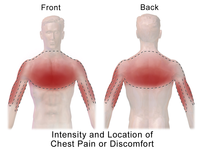
Photo from wikipedia
Background: Neck pain is a common musculoskeletal symptom that has negative effects on quality of life and work productivity. Acupuncture has been widely used for neck pain, and a number… Click to show full abstract
Background: Neck pain is a common musculoskeletal symptom that has negative effects on quality of life and work productivity. Acupuncture has been widely used for neck pain, and a number of randomized controlled trials (RCTs) and systematic reviews (SRs) have evaluated its effectiveness. However, previous studies have obtained inconsistent results regarding the effects of acupuncture for neck pain, and there is no SR for the comparative efficacy and safety of various types of acupuncture. Therefore, we herein conducted a SR and network meta-analysis to compare and rank different types of acupuncture with respect to their effectiveness in treating neck pain. Methods: We searched 9 electronic databases for relevant RCTs published from their inception to July 1, 2021. Pairwise meta-analyses and network meta-analysis were performed with R software using the frequentist framework. Change of pain intensity was assessed as the primary outcome, and change of pain-related disability and efficacy rate were assessed as secondary outcomes. The Cochrane risk of bias tool and the Grading of Recommendations Assessment, Development, and Evaluation (GRADE) instrument were used to evaluate the quality of the included RCTs and the certainty of the evidence. Results: A total of 65 RCTs involving 5266 participants and 9 interventions were included. Three network meta-analyses were constructed for the following: pain intensity (42 RCTs, 3158 participants), pain-related disability (21 RCTs, 1581 participants), and efficacy rate (40 RCTs, 3512 participants). The results indicated that fire acupuncture, electroacupuncture, and warm acupuncture were more effective than manual acupuncture in terms of pain intensity reduction and efficacy rate, and that electroacupuncture decreased pain-related disability more effectively than manual acupuncture. Fire acupuncture ranked first among the 9 interventions. The overall q of evidence was very low according to the GRADE assessment. The reported adverse events were not serious. Conclusion: Fire acupuncture, warm acupuncture, acupoint catgut embedding, and electroacupuncture ranked higher than other interventions (usual care, sham acupuncture, no treatment) in reducing the pain and disability index scores and the efficacy rate. However, the included trials were evaluated as being of low quality; thus, we recommend additional well-designed RCTs with larger sample sizes to confirm these findings. Systematic review registration: PROSPERO, CRD42021235274.
Journal Title: Medicine
Year Published: 2022
Link to full text (if available)
Share on Social Media: Sign Up to like & get
recommendations!